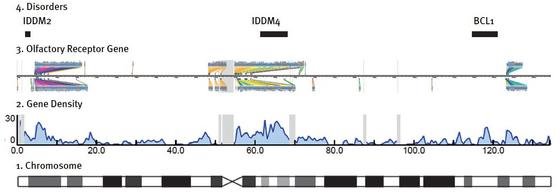Jun. 29, 2006 Research Highlight Biology Medicine / Disease
Analysis of human chromosome 11 complete
Researchers poised to mine a rich resource of novel genes on chromosome 11.
The most complete analysis of one of the most gene-rich chromosomes reveals a raft of novel genes and a rich resource for researchers studying the genetic basis of disease.
Chromosome 11 is of great interest to scientists because it has a very high density of genes. It also has an intriguing history, housing the first gene identified for a human genetic disease - the haemoglobin beta gene, which is mutated in sickle cell anaemia.
A team led by researchers at the RIKEN Genomic Sciences Center developed a new gene prediction program, called DIGIT, to analyze the complete sequence. According to Todd Taylor, a member of the team led by Yoshiyuki Sakaki, DIGIT combines the gene predicting power of several different programs. "It takes the best of the programs and reduces the number of false positives," says Taylor.
"Because chromosome 11 is so gene dense, it was a time consuming process to identify all the genes," says Taylor, "We also found many overlapping genes that complicated the analysis". The authors identified 2,347 genes, of which 230 were previously unknown and 765 are likely non-functional.
Because of its high-gene density, not surprisingly many diseases have been linked to chromosome 11, including various cancers and psychiatric conditions. However, the precise identity of the genes involved remains a mystery and, with the fully characterized sequence to hand, researchers are optimistic it will accelerate disease gene discovery.
Nearly half of the olfactory receptor genes are nestled on chromosome 11 and the authors thoroughly characterized their cluste red arrangement. According to Taylor, some scientists have postulated that olfactory genes originated on chromosome 11 and then duplicated within the chromosome, before duplicating further and spreading elsewhere in the genome.
During the study, the authors made an unexpected discovery: they found several cases of two adjacent genes producing a third transcript - in addition to their own transcripts - that is a hybrid of the two genes. In some cases, these transcripts make proteins, revealing a new potential group of proteins "and another layer of complexity to the genome," says Taylor.
The draft genome sequence was published in 2001 and the finished genome sequence in 2004. This study is the latest in a series of Nature publications, which provide the most comprehensive analysis of each chromosome1.
 Figure 1: Human Chromosome 11
Figure 1: Human Chromosome 11
References
- 1. Taylor T.D., et al. Human chromosome 11 DNA sequence and analysis including novel gene identification. Nature 440, 497-500 (2006). doi: 10.1038/nature04632
